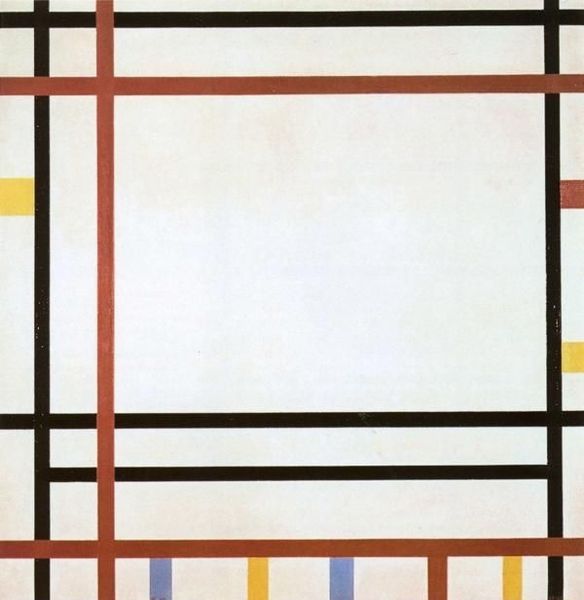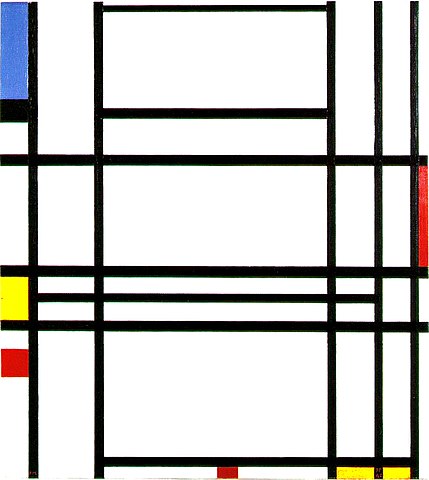
Piet Mondrian (1872–1944) was a Dutch modernist painter who died just over seventy years ago in New York, so the Thammasat University Libraries have made a timely acquisition of The Afterlife of Piet Mondrian by Nancy Troy.
We already have a few older books about Mondrian, but The Afterlife of Piet Mondrian has interesting new illustrations and more up-to-date research:
http://koha.library.tu.ac.th/cgi-bin/koha/opac-detail.pl?biblionumber=256966
http://koha.library.tu.ac.th/cgi-bin/koha/opac-detail.pl?biblionumber=66536
http://koha.library.tu.ac.th/cgi-bin/koha/opac-detail.pl?biblionumber=36627

Although Mondrian started out by making paintings with recognizable people or things, his work gradually became more abstract. Abstract art is also sometimes called non-representational, because we cannot see what it is supposed to represent, if it is supposed to represent any physical object at all. Some people are puzzled or confused by the strongly geometric design of Mondrian’s later works, and think that they must have been easy to accomplish. The famous saying of one supposed visitor to a modern art museum after looking at the abstract paintings was, “I have a ten year old child at home who can paint as well as that.” If we reserve judgment and look at enough abstract art, we can find that while some of it does seem easier than the rest, the best examples are solid achievements indeed. Not even a ten-year-old Mondrian could create works as complex and meaningful as the adult Mondrian did. Balancing the lines in a satisfying composition as Mondrian did can only be managed by a great artist, and he worked very hard to achieve his effects.
Spirituality in abstract art.
Mondrian was brought up in a Protestant family, but he was also interested in spiritual and philosophical studies. After 1908, he was involved in a mystical movement called Theosophy. This series of esoteric beliefs tried to understand the mysteries of nature, life, and religion. Esoteric is a word of Greek origin, originally meaning “belonging to an inner circle.” Esoteric beliefs are meant to be secret or hidden, unlike public beliefs. Mondrian’s Theosophy was also meant to be a way to acquire hidden knowledge or wisdom. Mondrian’s abstract artworks reflect this attempt to understand the universe’s mysteries. Mondrian’s fellow Dutch artist Theo van Doesburg said that there was a link between abstract works of art and ideals of peace and spirituality.

Looking patiently.
If you look carefully at Mondrian’s paintings, you may eventually see in them a kind of balance that is reassuring and calming. The colors are often joyful. The way the lines interact remind some viewers that Mondrian was very fond of dancing, and even named some of his works after the boogie-woogie, a popular American dance style. Also he was inspired by the hectic life of cities, and the rhythms of his forms remind some people of maps of cities and the way roads intersect.
Eventually Mondrian became so popular that his works inspired the decoration of hotels, high fashion dresses by the French designer Yves Saint Laurent, furniture, coffee cups, tea towels, and jigsaw puzzles. The Afterlife of Piet Mondrian discusses how the artist’s reputation became more widespread after his death. Even when he was alive, his paintings were used as backdrops for fashion photography in magazines. A Mondrian Hotel was constructed in North Hollywood, California in 1985 with a decoration in tribute to the artist covering its nine-story facade. Nowadays his paintings sell for over $40 million USD each. When he was alive, they never sold for more than $800 USD. Until around 1920 his paintings were of subjects like trees, but after that the designs no longer showed easily identifiable objects. Generally it is considered that Mondrian’s greatest works are the later ones, where we cannot tell what is meant to be shown in the painting. In 1914 he wrote to a fellow painter:

“I construct lines and color combinations on a flat surface, in order to express general beauty with the utmost awareness. Nature (or, that which I see) inspires me, puts me, as with any painter, in an emotional state so that an urge comes about to make something, but I want to come as close as possible to the truth and abstract everything from that, until I reach the foundation (still just an external foundation!) of things…”
Mondrian’s influence in Thailand.
Mondrian saw the lines he worked with as “basic forms of beauty” and many modern artists agree. Among his admirers today is the Thai artist Jirapat Tatsanasomboon. Born in 1971 in Samut Prakan province, Jirapat earned a master’s degree at Silpakorn University in 1999. His works show the interconnectedness of Thai and Western culture today. In such paintings as Confinement (after P. Mondrian) and Matrix of Tradition (after P. Mondrian), Jirapat shows us with some humor how Thai style and Mondrian’s style can work together. His works are featured in the influential new book 100 Painters of Tomorrow, which the TU Libraries do not own, but which is available from interlibrary loan.
Jirapat also created the witty painting Hanuman is Upset! In it, Hanuman the Hindu god and follower of Rama, a central character in the Ramayana, chews up the lines of a Mondrian-like design. By misbehaving, Hanuman the monkey god attacks Western tradition by devouring it instead of learning from it.

Keep cool and carry on.
One of the most impressive aspects of Mondrian’s work is that despite their apparent cool and balance, many were created at times of great stress. For example, when World War II broke out, Mondrian fled Fascist Europe to find freedom in America. There he worked, not distracted by tragic world events. If he had not died of pneumonia when he did, some art lovers claim that he would have made even more discoveries and innovations.
(all images courtesy of Wikimedia Commons).
